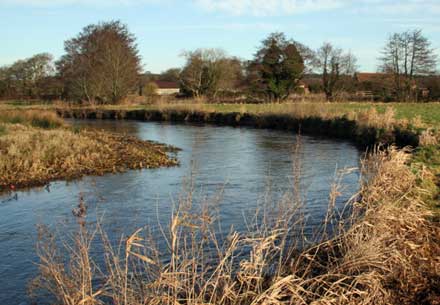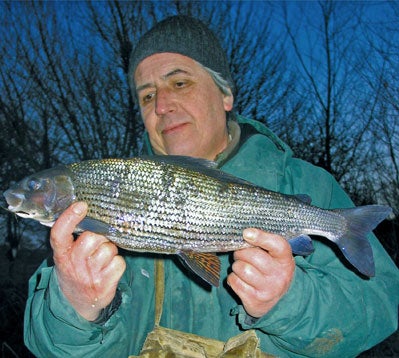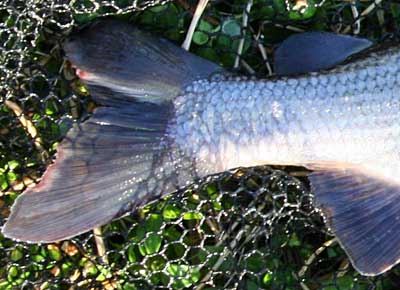| MARK WINTLE |
| Mark Wintle, an angler for thirty-five years, is on a quest to discover and bring to you the magic of fishing. Previously heavily involved with match fishing he now fishes for the sheer fun of it. With an open and enquiring mind, each week Mark will bring to you articles on fishing different rivers, different methods and what makes rivers, and occasionally stillwaters, tick. Add to this a mixed bag of articles on catching big fish; tackle design, angling politics and a few surprises. Are you stuck in a rut fishing the same swim every week? Do you dare to try something different and see a whole new world of angling open up? Yes? Then read Mark Wintle’s regular column. |
Wintle’s World of Angling – GraylingGRAYLING ARE ONE of the most beautiful fish in British waters. I enjoy catching them yet despair for their vulnerability.
First of all grayling are limited in their availability due mainly to their need for cool, well oxygenated, pure water. That generally means pure chalk streams and the upper reaches of our bigger rivers. I’ve had them from rivers as diverse as the Dorset Stour (rare as most of it is too slow), the Hampshire Avon, the Wye, the Yorkshire Derwent, the Test, a tiny tributary of the Bristol Avon, and my original home river, the home of massive grayling, the Dorset Frome. But that is only a very small sample of the waters where they can be found. What all of these waters do have in common is clean water. The first vulnerability then is to pollution. For many years grayling were persecutedTheir crime was that they supposedly ate all of the food that should have been making the trout fat, but in more recent times the fallacy of this has finally been exposed. The bad old days of netting and electro fishing seem to have finally passed and increasingly their value as a sport fish that can complement brown trout, whose habitat they often share, is being recognised. Being allowed to thrive and grow to a good size has been a good thing for grayling. Fishery owners have not been slow to recognise that an additional source of income during the autumn and winter months would come in handy, and so have opened up hitherto closed waters after the end of the trout season. That in itself is not a bad thing and nothing new, although there has been an increase in high-priced day ticket water – £ 10 to £ 15 per day seems typical. In the past it has been more a case of small village clubs and individuals getting access at low cost in the winter.
The effects of angling pressureWhat few people are admitting is what happens when grayling fishing is opened up to any significant amount of angling pressure. For example, I’ve fished the lower end of the Frome (the final 5 miles to the sea) for 35 years. My tally of grayling over 2lbs is just one, from the tidal stretch which is about the last place to get a big grayling. On our non-tidal stretches (the first three miles above the tidal) about 30 have come out of this size over many decades. Most are much smaller, and there is evidence that cormorant predation is annihilating the grayling on some stretches. Further upstream, a handful of anglers have had access to some very exclusive water that holds some exceptionally big grayling – we’re talking about fish over three pounds, and exceptionally pushing four pounds. After all that’s where the current record came from (4-4-0). Wherever the pressure on the grayling has increased, even slightly, the decline of the really big fish has been swift. Grayling grow fast in the exceptionally rich waters of the Frome but don’t live that long, possibly only eight years at maximum, most only living four or five years. One local club gained access to one of these upper beats and after two, perhaps three seasons it’s hard to catch a grayling, yet the first year or two there were plenty over two pounds, and up to three pounds. What doesn’t help is the catch at all costs attitude of some big fish men. Too much handling, photography, and being caught too often quickly takes its toll. One method used is a maggot feeder.
It catches grayling alright but far too many swallow the hook and die. If you want to read more about what happens to stretches like this (and it will happen on the Test and Itchen, as it has already happened on the Kennet) then read ‘First Cast’ by Terry Lampard. Grayling and keepnetsOn other stretches keepnet use doesn’t exactly help. The more enlightened clubs ban their use yet other clubs positively encourage the hammering of grayling by having a match the first weekend the trout season ends. I for one don’t want to catch tatty tailed and split dorsal finned grayling which seems to be the result of holding them in some of the shake-dry monofilament nets. Guidance from the Grayling SocietySo what is the answer? The Grayling Society provides the best guidance on the matter, and I hope they won’t mind if I reiterate some of their guidelines. The use of barbless hooks is recommended; grayling tend to squirm when trying to hold them, and this eases the unhooking considerably. Some anglers recommend holding them upside down, worth a try, and using a disgorger may make things easier as well. When returning fish hold the fish upright in the current facing upstream until it is recovered and able to swim away (similar to barbel). Do not retain grayling in keepnets. Personally I’d like the EA to classify grayling as a game fish and prohibit keeping them in keepnets altogether. This would extend their already protected status. For more information The Grayling Society |
















